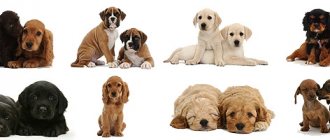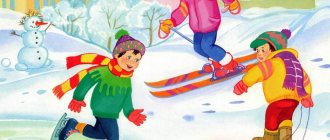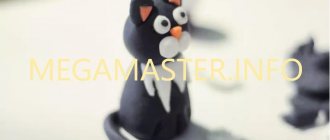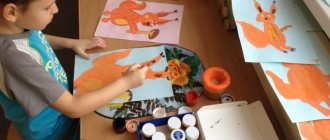DURING THE CLASSES
I. Organizational moment
II. Preparatory work
Teacher.
Today we will take a journey into the picture, and wizards who allow us to see the world in changes will help us with this. Who is this riddle about?
The furry little mustachioed one sits down and sings songs.
Children.
About the cat.
U.
And this?
A cat is sitting on the window: a tail like a cat’s, a nose like a cat’s, ears like a cat’s, not a cat’s.
D.
About the cat.
U.
About whom do they say: “He was born with a mustache”?
D.
About the kitten.
U.
Indeed, these riddles are about a toothy, furry animal, whose paw is soft, and whose claw is flaming, which, as soon as it starts to eat, sings a song. This beast is a cat. And the picture into which we will travel is called “Cat with Kittens.”
III. Working from a painting
Determining the composition of the picture
U.
Highlight the items or objects depicted in the picture.
Items are indicated by circles. The wizard of Delhi is involved in the work.
D.
Cat, gray kitten, plate, milk, rug, sleeping kitten, ball, basket, shelf, floor.
U.
Establish relationships between objects.
The magician Come on is involved in the work. Children make sentences by connecting two objects.
A game.
"Looking for friends"
Cat - kitten; plate - milk; milk - kitten.
A game
.
"Good bad"
The fairy Inversion is involved in the work.
Basket - balls - chaos - this is bad, but it’s also good, since the kitten plays and rolls the ball.
A game.
"Live Pictures"
Roles are assigned, and each child must find his place relative to other objects.
Object Representation
U.
The wizard I Only Hear came to us. What do you think he can hear in our picture?
D.
How kittens squeak, how a cat breathes, how a mother cat talks to her kittens.
U.
The wizard I Smell the Smell came to us. What can he feel?
D.
The smell of fresh milk.
U.
The wizard came to us. I Feel with My Face and Hands. What will he be able to feel?
D.
That the fur is soft, fluffy and smooth. The tongue is wet and warm. The nose is cold. The milk in the bowl is warm. The house is warm and dry.
U.
What can a wizard taste? I Taste? What is tasty and what is not tasty?
D.
I'm a kitten. Mom has very tasty milk, but the ball is tasteless.
The wizard Freeze-Otomri is involved in the work.
U.
What time of year and day has stopped in the picture? What happened to the kittens up to this point? What will happen tomorrow? And in a month?
In their answers, children use the words: before..., after..., then...
Making up riddles.
On the desk:
IV. Expanding and deepening students' knowledge
U.
At different times and in different countries, cats were treated differently.
In Ancient Egypt, she was idolized and given various honors. The death penalty awaited anyone who deliberately killed at least one of the grain barn guards. If a cat died a natural death, it was mourned and showered with gifts in the form of dried mice.
In Europe in the Middle Ages, the cat was persecuted because it was believed that the devil had settled in it. Black cats were especially unlucky. It was believed that they brought misfortune to the house.
In the Old Russian Code of Laws of the 16th century there is a mention that a fine of 3 hryvnia was established for a stolen cat. Is it a lot or a little? Judge for yourself: a bull or a cow cost the same.
Some people loved them, but others were afraid and drove them away, considering them witches. The cat is not a goddess, but not a witch either. This is an ordinary animal, but with extraordinary qualities.
Student 1.
Cats have very sensitive hearing: they hear even the smallest rustle that mice make. At the same time, they may not pay attention to the loud music that is heard in their ears.
Student 2.
Cats are very clean and wash themselves frequently. Do you know why? They lick not so much dirt as their own scent. All cats, both wild and domestic, are hunters. They hunt from ambush. If the prey smells danger, the cat will remain hungry.
Student 3.
Cats have very sharp eyesight. Their eyes have been compared to car reflectors. In semi-darkness, their eyes can be replaced by a greenish shine. Cats' eyes are large and look in one direction.
Student 4.
Cats correctly determine the distance to an object.
They walk calmly in the dark. They are helped in this by vibraces
- long, stiff hairs that we call mustaches.
Student 5.
Cats walk silently, retracting their claws and walking with small pads. They climb deftly and can jump from heights. In New York, one cat jumped from the 33rd floor - and no matter what.
Student 6.
Here are some facts about cats that can be found in the Guinness Book of Records:
- There are currently about 5 billion people living on Earth, but there are only 400 million cats.
- The largest number of cats is in the USA – there are about 55 million of them.
- The average lifespan of a cat is 20 years.
- The champion among long-livers is the Puss cat from the USA: she lived for 36 years.
- Typically, a cat gives birth to 3–5 kittens. But a cat named Bell from South Africa gave birth to 14 kittens at once.
- Minnie the cat caught 12,480 rats between 1927 and 1933.
V. Physical education minute
VI. Compiling stories on behalf of different objects
I AM A BOWL WITH MILK
The owner knows that the cat Masha and her little kittens love milk very much, so early in the morning, when the cow is milked, she pours warm milk into me. How nice it is when kittens lap milk from me! They drip from the spout, and the tongues are rough and very mobile. I am happy that I am of such benefit.
I AM THE EYES OF CAT MOTHER
I have a lot of work to do all day. Kittens are small, nimble, and you need to keep an eye on them. Look, look, how my white kitten plays! He is confused - he urgently needs help. And the gray kitten laps up the milk - let him eat his fill. Where's the third kitten? Yes, here he is, lying next to him, so warm, and purring: “Mr-mr.”
VII. Working on proverbs and sayings about cats
- They live like a cat and a dog.
- Cats scratch my soul.
- Everything is down the drain.
- At night all cats are gray.
- The cat was jealous of the dog's life.
VIII. Lesson summary
U.
What do you remember from the lesson? Come up with a theme for your next trip to the picture.
Looking at the painting “Cat with Kittens”
Kristina Shamonova
Looking at the painting “Cat with Kittens”
Development of a synopsis of direct educational activities, including children’s perception of works of art. Looking at the painting “ Cat with Kittens ”
Goal: to develop the ability to carefully consider the characters in a plot picture , answering questions about its content.
• Learn to name animals and their babies, the habits of cats, what animals can do;
• Teach children to compose a story based on a plot picture , formulate answers to a question;
• Use means of intonation expressiveness in the process of communication with peers and adults.
• Develop creative abilities in children;
• Activate words in speech that denote the actions of the animal.
• Foster a caring attitude towards nature;
• Cultivate interest in understanding the world around us.
Preliminary work: reading poems about domestic animals ( cat )
;
singing the song “Little Gray Kitty”
; telling riddles about animals.
Individual work: teach Oksana K. to name baby animals, teach Egor E. to come up with names for kittens , teach Arthur P. to talk about kittens .
Vocabulary work: bearded, funny, playing with balls, lapping milk, housewife, hunting.
Interrelation with other types of activities: cognitive development (FCCM, artistic and aesthetic development (drawing, physical development, social and communicative development.
Demonstration material: painting “ Cat with Kittens ”
,
pictures of animals and their young, sheets of paper with images of
Handouts: paints, brushes, brush holders, napkins, sippy cups.
Lesson on speech development in the second junior group “Cat with kittens” viewing a picture
LESSON ON SPEECH DEVELOPMENT IN THE SECOND YOUNGER GROUP “CAT WITH KITTENS” (EXAMINING A PICTURE)
Goal: development of speech of preschoolers by means of familiarization with the environment Objectives: Educational: - consolidate and expand children’s knowledge about the cat; - help children understand the content of the picture, look at the cat, kittens, characterize the animals; - develop the ability to read poetry by heart; — develop the ability to convey the image of an animal in applications, arouse interest in teamwork. Developmental: develop attention, memory, thinking, coherent speech Educational: cultivate a friendly attitude towards pets; develop the ability to listen to the teacher’s story; develop the ability to listen to your friend and not interrupt. integration of areas: “communication”, “cognition”, “artistic creativity (application)” “reading fiction”, Lexical dictionary: Words-objects
: cat, head, mustache, ears, eyes, paws, tail, milk, saucers, mouse.
Sign words
: white, fluffy, soft, red, small, black with white spots.
Action words
: meows, sleeps, laps, plays.
material:
painting “cat with kittens”, cat toy, oilcloth, cat template, PVA glue, brush, cotton wool,
Progress of the lesson:
Educator:
Guys, let's say hello to the guests and get ready to listen.
The teacher asks the children to guess the riddle: “Soft paws, but there are scratches in their paws.” (cat)
That's right, it's a cat. (watch the presentation on the screen): A cat is a very caring mother. She is a clean animal. He loves his owners and his home. She loves to nap in the sun or in a chair at home. If the cat is well-fed and healthy, then it purrs affectionately and rubs against its owner’s legs. And if a cat wags its tail, it is dissatisfied with something. The cat licks helpless blind kittens and feeds them milk. The cubs grow quickly and turn into cute, cheerful kittens - gamblers. They enjoy playing with a piece of paper tied to a thread, rolling a ball of wool or a small ball. Guys, who knows poems about a cat? Did someone meow at the door? Open it quickly! It's very cold in spring, the cat is asking to go home!
The cat sat down under a bush, ate a piece of cheese. The cat stood up, stretched, and her fur unfurled.
Pussy is busy all day long, She keeps sharpening her claws. She sharpened it, went to bed, and in her sleep said: “meow”
You know me closely, I am a friendly pussy. At the top are tassels on the ears. The claws are hidden in the pillows. I can see clearly in the dark. I won't offend you in vain. But teasing me is dangerous. I scratch terribly. Physical minute: the pussy was shaking the strings (rotate the hands, as if winding the thread around a ball) And sold the balls (pull both palms forward) How much does it cost? Three rubles! Buy from me (show three fingers, clench and unclench your fists) Look, guys, who is depicted in this picture? (Cat with kittens). Yes, this is a cat with her young kittens. How do you say the word cat or kitten in the Bashkir language? Guys, what is the cat doing? (The cat is resting, lying on the rug) - what color is the cat? What's her breast like? (the cat is gray in color, with a white chest - What kind of paws does the cat have? (The cat’s paws are soft, gray) - What’s on the cat’s paws? (Scratches, sharp claws) - Guys, what color is the cat’s tail? (The tail is gray ) - Is a cat’s tail long or short? (Is the tail long) - What does a cat have on its head? (A cat has ears on its head) - Why do cats have ears? (To hear) - What does a cat have on its face? (Eyes, nose , mouth, mustache) - what kind of eyes (green, big), why does a cat need whiskers (antennas) - The cat’s eyes are big, green, attentive, clear. And what kind of cat is it big or small? (The cat is big) Try to repeat everything that we told about the cat. What kind of cat? What kind of chest and front legs does it have? Muzzle? Back and tail? Ears? Eyes and whiskers? What does the cat do? The cat is big, fluffy. She has a white chest and front legs, a red and white muzzle, red back and tail, pointed ears, green eyes and long mustache. The cat lies and looks at the kittens. - Now let's look at the kittens and tell about them. - How many kittens, let's count. (the cat has three kittens) - What is the red kitten doing? (The red-haired kitten laps milk, drinks, eats) - how to say “milk” in the Bashkir language - And what does he lap milk from? (Lapping milk from a saucer) - What color is this kitten? (This kitten is gray) - What is the kitten touching with its paw? (A ball of thread, plays) - how to say “plays” in the Bashkir language - What color is the ball? (Blue ball) - where do you think this ball came from? (children's answer options) - What does a striped kitten do? (The kitten is sleeping). Yes, guys, he is sleeping, he has already played, now he is resting. He feels warm next to his mother's cat. — how to say “sleeping” in Bashkir — Guys, do kittens have long or short tails? (Kittens have a short tail) - Do kittens have big or small ears? (Little ears) And now I’ll tell you a short story about a kitten: A gray kitten plays with its mother cat. He's small and funny. He has a white muzzle, a short tail, big eyes and pointed ears. He stands on his hind legs, plays with a ball - and now let's talk about other kittens - Who wants to talk about the kitten who sleeps on the rug? What is his face, chest, paws, ears and antennae like? Children. One kitten sleeps on the rug. He has a white and gray muzzle, a white chest and paws, pointed ears and long antennae. He closed his eyes tightly. - What is another red kitten doing? Tell us about it. Children. A ginger kitten sits near a saucer of milk. It has a white chest and white paws, and a striped tail. The kitten has beautiful yellow eyes and a pink nose.
2. And now, guys, we will play the outdoor game “Cat and Kittens” on the carpet. Educator: I will be a mother cat, and you will be my children, kittens. The kittens woke up, stretched, washed their faces with their paws, smiled and began to play, run, and jump. (The teacher takes a soft fluffy cat toy.) Mother cat “purr” (kittens run, jump). “Meow,” the kittens ran up to the cat’s mother. Educator: Guys, touch my fur. She is soft and fluffy. (Children touch a soft toy cat). (The game is played for 2-3 days.) Educator: Guys, our mother cat had another white kitten, but he got lost, the cat mother was upset, let’s help her find this kitten. Children go to the tables, where the applique blank, glue, brush, napkins, cotton wool have already been prepared.
Now you and I will make the cat ourselves, I will smear the template with glue, and you will help me make fur from cotton wool, tear off a little cotton wool and glue it on. (distribute who glues which part of the cat) Let's finish the cat's eyes, nose, mouth, mustache Glue the cat onto cardboard (put the cat on a magnetic board) Result.
Now the mother cat has found her white kitten. What new did we learn about the cat today, what is it like? (fluffy, affectionate) What do cats like to do? What do they like to eat? How do you take care of your kittens? Guys, this is the end of our lesson.




